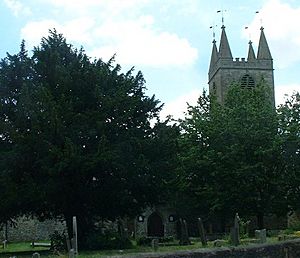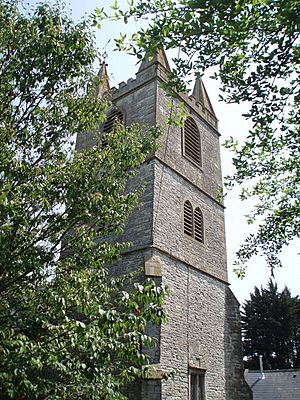Church of St Peter, Marksbury facts for kids
Quick facts for kids Church of St Peter |
|
|---|---|
 |
|
| Location | Marksbury, Somerset, England |
|
Listed Building – Grade II*
|
|
| Designated | 1 February 1954 |
| Reference no. | 1320777 |
| Lua error in Module:Location_map at line 420: attempt to index field 'wikibase' (a nil value). | |
The Church of St Peter is a very old church located in Marksbury, a village in Somerset, England. It was first built way back in the 12th century, which means it's over 800 years old! Even though it's so ancient, much of what you see today was built in the 15th century. This church is considered a special historical building, known as a Grade II* listed building, which means it's very important and protected.
Contents
Inside the Church
The main part of the church where people sit is called the nave. It has windows that let in light and an old doorway from 1627 that is now closed off. The chancel is the area near the altar, where the choir and clergy sit. It's a bit off-center from the nave and has a large window from 1875. The church also has an organ chamber that was added in 1893.
Special Features
- The main altar is a beautiful oak table made in the Jacobean style, which was popular in the 1600s. It was made by Francis Leyborne Popham.
- There's another altar table in the tower that used to be in a nearby church.
- The font, which is a basin used for baptisms, is very old and dates back to the Norman period. This means it's from the 11th or 12th century!
The Church Tower
The church has a tall, three-story tower that stands out. It has strong supports called buttresses to keep it steady. There's a small, old door on the west side of the tower. As you look up, you'll see different types of windows on each level. The very top of the tower has a decorative wall called a parapet and four pointy decorations called pinnacles. These pinnacles even have weather vanes on top!
Church Bells
In 1782, the church had four bells. These bells were sent to a famous bell-making family, the Bilbie family, to be melted down and made into a new set of six bells. One of these bells cracked in 1820 and had to be recast in London. In the early 1900s, the tower got a new roof, and the bells were rehung so they could ring clearly again.
People Connected to the Church
The Church of St Peter is home to several old monuments and memorials. These are like special plaques or sculptures that remember people who were important to the church or the area.
Notable Memorials
- You can find monuments in the chancel for families like the Counsells (from 1671) and the Waddens (from 1682).
- In the nave, there's a monument for Boulter from 1782, created by a craftsman named Brewer.
- Reverend William Counsell was the rector, or head priest, of the church from 1662 to 1674.
- Francis Popham, a notable person from Littlecote House, was buried in the church's chancel in 1779.
- One of the beautiful stained glass windows in the church is a memorial to a local person who sadly lost her life in the Great Flood of 1968, when the River Chew overflowed.
Joseph Harding, "Father of Cheddar Cheese"
The churchyard is also the resting place of Joseph Harding. He was a very important person in the history of cheese making. He's often called the "father of Cheddar cheese" because he helped create the modern ways of making this popular cheese. There's a special memorial plaque for him inside the church, which was moved there from a different chapel.
See also
- List of ecclesiastical parishes in the Diocese of Bath and Wells


